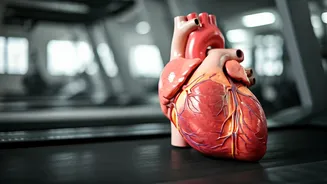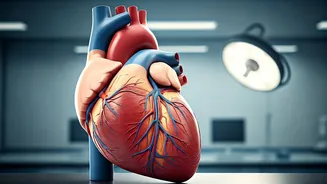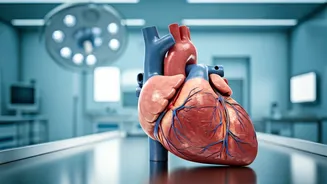Why Exercise Matters
Exercise is a cornerstone of good health, influencing nearly every aspect of your well-being. Regular physical activity helps maintain a healthy weight
by burning calories and building muscle mass. This is crucial because being overweight or obese increases the risk of numerous health problems. Beyond weight management, exercise significantly improves cardiovascular health. It strengthens the heart, lowers blood pressure, and reduces the risk of heart disease and stroke. It also has a positive impact on mental health. Exercise releases endorphins, which have mood-boosting effects. This can help alleviate symptoms of depression and anxiety, promoting overall mental clarity and focus. Additionally, exercise can improve sleep quality, reduce the risk of chronic diseases, and even boost your energy levels. Incorporating exercise into your daily routine is a proactive step toward a healthier and more fulfilling life.
Heart Health Benefits
The positive effects of exercise on the heart are numerous and vital for longevity. Regular physical activity strengthens the heart muscle, making it more efficient at pumping blood. This efficiency leads to a lower resting heart rate, reducing the strain on the cardiovascular system. Exercise also helps regulate blood pressure. It can lower both systolic and diastolic blood pressure, decreasing the risk of hypertension, a major risk factor for heart disease. Furthermore, exercise improves cholesterol levels. It helps increase high-density lipoprotein (HDL) cholesterol, often referred to as 'good' cholesterol, while lowering low-density lipoprotein (LDL) cholesterol, or 'bad' cholesterol. This balance is crucial for preventing the buildup of plaque in arteries, which can lead to blockages and heart attacks. Engaging in regular exercise, like brisk walking, jogging, swimming, or cycling, provides these crucial benefits, supporting long-term heart health.
Managing Weight Effectively
Exercise plays a key role in weight management by helping you burn calories and build muscle. When you exercise, your body utilizes calories to fuel the activity, thereby reducing the number of calories stored as fat. Additionally, exercise increases your metabolic rate, which is the rate at which your body burns calories, both during exercise and at rest. Building muscle mass through strength training further enhances your metabolism because muscle tissue burns more calories than fat tissue. A combined approach of regular exercise and a balanced diet is most effective for weight management. Consistent physical activity helps you achieve a calorie deficit, where you burn more calories than you consume. This deficit is essential for weight loss. Choosing a variety of exercises, such as cardio and strength training, will target different aspects of weight management, promoting overall fitness and well-being. It helps improve body composition by decreasing body fat and increasing muscle mass.
Boosting Mental Wellbeing
The link between exercise and mental well-being is powerful and well-established. Exercise acts as a natural mood booster. During physical activity, the body releases endorphins, which are chemicals that act as natural mood lifters. These endorphins can reduce feelings of stress, anxiety, and depression, contributing to a sense of well-being. Exercise also improves sleep quality, which is crucial for mental health. Regular physical activity can help regulate your sleep-wake cycle, leading to better sleep patterns. This, in turn, can reduce fatigue, improve mood, and enhance cognitive function. Moreover, exercise can boost self-esteem and confidence. Achieving fitness goals and seeing physical improvements can provide a sense of accomplishment and increase your self-worth. Activities like yoga and meditation, often combined with exercise, can further enhance mindfulness and reduce stress levels. Incorporating exercise into your routine is a simple yet effective strategy for enhancing mental clarity and emotional resilience.
Types of Exercises
There are numerous types of exercises that can be incorporated into a fitness routine, each offering unique benefits. Cardiovascular exercises, such as running, swimming, cycling, and brisk walking, are excellent for improving heart health and burning calories. These activities elevate your heart rate and improve blood circulation. Strength training, including weightlifting and bodyweight exercises, builds muscle mass, which boosts metabolism and improves bone density. These exercises are crucial for maintaining strength and preventing age-related muscle loss. Flexibility exercises, like stretching and yoga, enhance range of motion and reduce the risk of injuries. Stretching improves muscle elasticity and reduces muscle tension. High-Intensity Interval Training (HIIT) involves short bursts of intense exercise followed by brief recovery periods. HIIT is very efficient for burning calories and improving cardiovascular fitness in a short amount of time. Consider combining different types of exercises to create a balanced routine that addresses all aspects of physical fitness and makes workouts more engaging.
Incorporate Exercise Daily
Integrating exercise into your daily life can be achieved through small, consistent changes in your routine. Start by setting realistic goals, such as aiming for 30 minutes of moderate-intensity exercise most days of the week. Break down your exercise into shorter sessions if needed; even 10-minute bursts of activity can be beneficial. Find activities you enjoy, whether it’s dancing, playing a sport, or taking walks in nature, which makes it easier to stay motivated. Schedule exercise like any other important appointment to ensure you prioritize it. Use your commute as an opportunity for physical activity; consider walking or cycling to work or during breaks. Make exercise a social activity by joining a fitness class or exercising with friends or family. This adds an element of enjoyment and accountability. Gradually increase the intensity and duration of your workouts as your fitness level improves. Consistency is key, so make exercise a regular part of your daily life to experience long-term health benefits. Small steps will build up to long-term sustainable changes to your lifestyle.
Risks of Inactivity
The absence of regular exercise can lead to various health issues, underscoring the importance of physical activity. Inactivity increases the risk of chronic diseases, such as heart disease, type 2 diabetes, and certain types of cancer. Sedentary lifestyles contribute to the buildup of plaque in arteries, impairing blood sugar control, and increasing the risk of abnormal cell growth. Inactivity often leads to weight gain and obesity, which further increases the likelihood of health problems. Lack of exercise weakens muscles and bones, raising the risk of falls and fractures. Physical inactivity also negatively impacts mental health, increasing the risk of depression and anxiety. Furthermore, a sedentary lifestyle often results in poor sleep quality and decreased energy levels. Prolonged periods of sitting can also contribute to back pain and poor posture. The cumulative effects of inactivity highlight the necessity of regular exercise for both physical and mental well-being and illustrate the potential benefits of making a lifestyle change to include regular movement.













